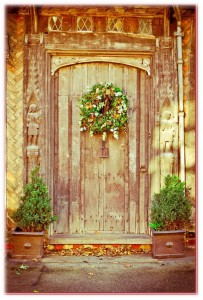For today’s post, I decided to return to medieval history, taking a break from the recent posts that speak to astrological events and Dr. Bach’s flower remedies. No question, there is and will be a great deal more out there regarding interpretations of the Mayan Calendar, today’s Solstice and the tightening of the Pluto-Uranus square, among other astro-events to keep us on our toes.
Despite the recent horrors we’ve witnessed in the global news, still… much of the world is in the throes of celebration leading up to, what was known as the Christ-Mass. I thought it would interesting to visit (or for some, re-visit) where these traditions, many still very much alive today, originated. With my warm wishes and blessings for you and yours this holiday season, I offer the following excerpt from, Pleasures and Pastimes of Medieval England, written by Compton Reeves and published by Oxford University Press, 1998.
“Our word Christmas is derived from the Middle English usage “Christ’s Mass,” and central to the celebration of the Nativity was the liturgical activity which had been established by the year 600, and did not change in the Middle Ages. In Medieval England there were, in fact, three Masses celebrated on Christmas Day. The first and most characteristic was at midnight (the Angel’s Mass), catching up the notion that the light of salvation appeared at the darkest moment of the darkest date in the very depth of winter. The second Christmas Mass came at dawn (the Shepherd’s Mass), and the third during the day (the Mass of the Divine Word). The season of Advent, the forty days of leading up to Christmas, was being observed in the Western Church by the year 500. St. Nicholas was a very popular Medieval saint, and his feast day came in Advent (6 December), but he did not play his part in Christmas as Santa Claus until after the Reformation.
Also important in the celebration of Christmas was the banquet, which necessarily varied in sumptuousness with the resources of the celebrants. The menu varied with soups and stews, birds and fish, breads and puddings, but a common element was the Yule boar, an animal for those who could afford it or a pie shaped like a boar for more humble tables. Churches and houses were decorated with ivy, mistletoe, holly or anything green, which remained up until the eve of Candlemass. The gift-giving of the season was represented by the New Year Gift, which continued a tradition of Roman origin. The later Christmas present was not part of a Medieval Christmas. The sorts of things that people might have done to entertain themselves at Christmas apart from eating is succinctly summarized in a letter written by Margaret Paston on Christmas eve 1459 after she had inquired how her Norfolk neighbor, Lady Morley, had conducted her household in mourning the previous Christmas, just after Lady Morley had been widowed:
“…there were no disguisings[acting], nor harping, luting or singing, nor any lewd sports, but just playing at the tables[backgammon] and chess and cards. Such sports she gave her folk leave to play and no other.”
A medieval Christmas celebration was not over in a day, but continued until 6 January(the Egyptian winter solstice), the Feast of the Epiphany on the 12th day after Christmas Day. Epiphany celebrated the visit of the wise men, the Magi, around whom many layers of legend accumulated as they came to be conceptualized as three oriental kings who visited the infant Christ at Bethlehem in Judea. Epiphany also symbolized the manifestation of Christ to the Gentiles. The Monday after Epiphany was called Plough Monday, and it was then that ploughing began.
There was no absolute standard about ending the Christmas season with Epiphany, and many carried it through to forty days after Christmas, the date of an ancient pagan festival on 2 February. This is now celebrated as Candlemas, or the Feast of the Purification of the Virgin, or alternatively as the Presentation of the Infant Jesus in the Temple. In one of the most elaborate processions of the year, all parishioners came to Mass with a penny and a candle blessed before the procession, both of which were offered to the priest as part of the parochial duties of the faithful. Other candles were blessed and taken away by the faithful to be used for such things as giving comfort during thunder storms or while sick or even dying. Such candles were thus important for giving people a light of solace in the face of hostile forces and stressful events. And thus Candlemas was a closure for the long season commencing with Advent that drew Medieval Christians to concentrate on the miraculous gift to humanity of Christ, and the promise of salvation, while leaving at the same time space for fun, feasting, and socializing.”

You can follow me on: https://www.facebook.com/gayemackauthor or https://www.twitter.com/gayemack
